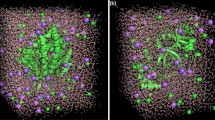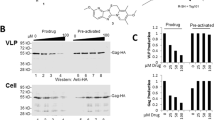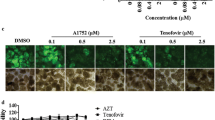Abstract
Virus mutates quickly and develops drug resistance over time if targeted directly. A possible alternative for drug design is to target cellular proteins that the virus needs. To be viable, the drug ought to inhibit the cellular protein only when bound by viral protein. We use a particular virus–host complex to illustrate how to identify such an inhibitor. HIV-1 uses its viral protein Tat to hijack a cellular protein complex Cdk9/Cyclin T1, termed positive elongation factor b (p-TEFb), to enhance its viral transcription. Tat binds to both Cdk9 and Cyclin T1 and thus creates a second pathway between Cdk9 and Cyclin T1 that is distinct from the Cdk9/Cyclin T1 interface. Dynamical network analysis based on molecular dynamics simulations reveals a pocket on Cdk9 that becomes allosterically correlated with the interface via the second pathway. Computational docking simulations indicate a noticeable weakening of the interface formation of Cdk9 and Cyclin T1 upon binding of a small molecule F07#13 to the pocket and Tat to the complex. We verified experimentally via site mutagenesis that F07#13 indeed targets this pocket and diminishes the kinase activity of Cdk9 in the presence of Tat. Together with previous experiments that showed little effect of F07#13 in the absence of Tat, the proposed computational framework therefore provides some insights on how to design antiviral drugs with reduced risk of drug resistance.







Similar content being viewed by others
References
Ahlquist P, Noueiry AO, Lee WM, Kushner DB, Dye BT (2003) Host factors in positive-strand RNA virus genome replication. J Virol 77(15):8181–8186
Baumli S, Lolli G, Lowe ED, Troiani S, Rusconi L, Bullock AN et al (2008) The structure of P-TEFb (CDK9/cyclin T1), its complex with flavopiridol and regulation by phosphorylation. EMBO J 27(13):1907–1918. https://doi.org/10.1038/emboj.2008.121
Baumli S, Endicott JA, Johnson LN (2010) Halogen bonds form the basis for selective P-TEFb inhibition by DRB. Chem Biol 17(9):931–936. https://doi.org/10.1016/j.chembiol.2010.07.012
Bettayeb K, Baunbaek D, Delehouze C, Loaec N, Hole AJ, Baumli S et al (2010) CDK inhibitors roscovitine and CR8 trigger Mcl-1 down-regulation and apoptotic cell death in neuroblastoma cells. Genes Cancer 1(4):369–380. https://doi.org/10.1177/1947601910369817
Betzi S, Alam R, Martin M, Lubbers DJ, Han H, Jakkaraj SR et al (2011) Discovery of a potential allosteric ligand binding site in CDK2. ACS Chem Biol 6(5):492–501. https://doi.org/10.1021/cb100410m
Bigna JJ, Plottel CS, Koulla-Shiro S (2016) Challenges in initiating antiretroviral therapy for all HIV-infected people regardless of CD4 cell count. Infect Dis Poverty 5(1):85. https://doi.org/10.1186/s40249-016-0179-9
Butera ST, Roberts BD, Lam L, Hodge T, Folks TM (1994) Human immunodeficiency virus type 1 RNA expression by four chronically infected cell lines indicates multiple mechanisms of latency. J Virol 68(4):2726–2730
Canduri F, Perez PC, Caceres RA, de Azevedo WF (2008) Jr. CDK9 a potential target for drug development. Med Chem 4(3):210–218
Chen H, Van Duyne R, Zhang N, Kashanchi F, Zeng C (2009) A novel binding pocket of cyclin-dependent kinase 2. Proteins 74(1):122–132. https://doi.org/10.1002/prot.22136
Chen H, Zhao Y, Li H, Zhang D, Huang Y, Shen Q et al (2014) Break CDK2/Cyclin E1 interface allosterically with small peptides. PLoS ONE 9(10):e109154. https://doi.org/10.1371/journal.pone.0109154
Darden T, York D, Pedersen L (1993) Particle mesh Ewald: an N⋅log(N) method for Ewald sums in large systems. J Chem Phys 98:10089–10092
del Sol A, Tsai CJ, Ma B, Nussinov R (2009) The origin of allosteric functional modulation: multiple pre-existing pathways. Structure 17(8):1042–1050. https://doi.org/10.1016/j.str.2009.06.008
Dror RO, Dirks RM, Grossman JP, Xu H, Shaw DE (2012) Biomolecular simulation: a computational microscope for molecular biology. Annu Rev Biophys 41:429–452. https://doi.org/10.1146/annurev-biophys-042910-155245
Edgar RC (2004) MUSCLE: multiple sequence alignment with high accuracy and high throughput. Nucleic Acids Res 32(5):1792–1797. https://doi.org/10.1093/nar/gkh340
Fernandez G, Zeichner SL (2010) Cell line-dependent variability in HIV activation employing DNMT inhibitors. Virol J 7:266. https://doi.org/10.1186/1743-422X-7-266
Forli S, Olson AJ (2015) Computational challenges of structure-based approaches applied to HIV. Curr Top Microbiol Immunol 389:31–51. https://doi.org/10.1007/82_2015_432
Fuglestad B, Gasper PM, McCammon JA, Markwick PR, Komives EA (2013) Correlated motions and residual frustration in thrombin. J Phys Chem B 117(42):12857–12863. https://doi.org/10.1021/jp402107u
Girvan M, Newman ME (2002) Community structure in social and biological networks. Proc Natl Acad Sci USA 99(12):7821–7826. https://doi.org/10.1073/pnas.122653799
Glykos NM (2006) Software news and updates. Carma: a molecular dynamics analysis program. J Comput Chem 27(14):1765–1768. https://doi.org/10.1002/jcc.20482
Greene LH, Higman VA (2003) Uncovering network systems within protein structures. J Mol Biol 334(4):781–791
Heredia A, Le N, Gartenhaus RB, Sausville E, Medina-Moreno S, Zapata JC et al (2015) Targeting of mTOR catalytic site inhibits multiple steps of the HIV-1 lifecycle and suppresses HIV-1 viremia in humanized mice. Proc Natl Acad Sci USA 112(30):9412–9417. https://doi.org/10.1073/pnas.1511144112
Hess B, Bekker H, Berendsen HJC, Fraaije JGEM (1997) LINCS: a linear constraint solver for molecular simulations. J Comput Chem 8(12):1463–1472. https://doi.org/10.1002/(SICI)1096-987X(199709)18:12%3C1463::AID-JCC4%3E3.0.CO;2-H.
Huang Y, Niu B, Gao Y, Fu L, Li W (2010) CD-HIT suite: a web server for clustering and comparing biological sequences. Bioinformatics 26(5):680–682. https://doi.org/10.1093/bioinformatics/btq003
Humphrey W, Dalke A, Schulten K (1996) VMD: visual molecular dynamics. J Mol Graph 14(1):33–38 (27–28).
Hunenberger PH, Mark AE, van Gunsteren WF (1995) Fluctuation and cross-correlation analysis of protein motions observed in nanosecond molecular dynamics simulations. J Mol Biol 252(4):492–503. https://doi.org/10.1006/jmbi.1995.0514
Ichiye T, Karplus M (1991) Collective motions in proteins: a covariance analysis of atomic fluctuations in molecular dynamics and normal mode simulations. Proteins 11(3):205–217. https://doi.org/10.1002/prot.340110305
Ivetac A, McCammon JA (2010) Mapping the druggable allosteric space of G-protein coupled receptors: a fragment-based molecular dynamics approach. Chem Biol Drug Des 76(3):201–217. https://doi.org/10.1111/j.1747-0285.2010.01012.x
Ivetac A, McCammon JA (2012) A molecular dynamics ensemble-based approach for the mapping of druggable binding sites. Methods Mol Biol 819:3–12. https://doi.org/10.1007/978-1-61779-465-0_1
Jäger S, Cimermancic P, Gulbahce N, Johnson JR, Mcgovern KE, Clarke SC et al (2011) Global landscape of HIV–human protein complexes. Nature 481(7381):365
Karplus M, McCammon JA (2002) Molecular dynamics simulations of biomolecules. Nat Struct Biol 9(9):646–652. https://doi.org/10.1038/nsb0902-646
Krystof V, Uldrijan S (2010) Cyclin-dependent kinase inhibitors as anticancer drugs. Curr Drug Targets 11(3):291–302
Krystof V, Baumli S, Furst R (2012) Perspective of cyclin-dependent kinase 9 (CDK9) as a drug target. Curr Pharm Des 18(20):2883–2890
Kumari N, Iordanskiy S, Kovalskyy D, Breuer D, Niu X, Lin X et al (2014) Phenyl-1-Pyridin-2yl-ethanone-based iron chelators increase IkappaB-alpha expression, modulate CDK2 and CDK9 activities, and inhibit HIV-1 transcription. Antimicrob Agents Chemother 58(11):6558–6571. https://doi.org/10.1128/AAC.02918-14
Landau M, Mayrose I, Rosenberg Y, Glaser F, Martz E, Pupko T et al (2005) ConSurf 2005: the projection of evolutionary conservation scores of residues on protein structures. Nucleic Acids Res 33(Web Server issue):W299–W302. https://doi.org/10.1093/nar/gki370
Lengauer T, Rarey M (1996) Computational methods for biomolecular docking. Curr Opin Struct Biol 6(3):402–406
Lewis JA, Lebois EP, Lindsley CW (2008) Allosteric modulation of kinases and GPCRs: design principles and structural diversity. Curr Opin Chem Biol 12(3):269–280. https://doi.org/10.1016/j.cbpa.2008.02.014
Li L, Li C, Sarkar S, Zhang J, Witham S, Zhang Z et al (2012) DelPhi: a comprehensive suite for DelPhi software and associated resources. BMC Biophys 5:9. https://doi.org/10.1186/2046-1682-5-9.
Li L, Jia Z, Peng Y, Chakravorty A, Sun L, Alexov E (2017) DelPhiForce web server: electrostatic forces and energy calculations and visualization. Bioinformatics 33(22):3661–3663. https://doi.org/10.1093/bioinformatics/btx495
Malumbres M, Harlow E, Hunt T, Hunter T, Lahti JM, Manning G et al (2009) Cyclin-dependent kinases: a family portrait. Nat Cell Biol 11(11):1275–1276. https://doi.org/10.1038/ncb1109-1275
Morgan DO (1995) Principles of CDK regulation. Nature 374(6518):131–134. https://doi.org/10.1038/374131a0
Narayanan A, Sampey G, Van Duyne R, Guendel I, Kehn-Hall K, Roman J et al (2012) Use of ATP analogs to inhibit HIV-1 transcription. Virology 432(1):219–231. https://doi.org/10.1016/j.virol.2012.06.007
Narayanan A, Iordanskiy S, Das R, Van Duyne R, Santos S, Jaworski E et al (2013) Exosomes derived from HIV-1-infected cells contain trans-activation response element RNA. J Biol Chem 288(27):20014–20033. https://doi.org/10.1074/jbc.M112.438895
Nemeth G, Varga Z, Greff Z, Bencze G, Sipos A, Szantai-Kis C et al (2011) Novel, selective CDK9 inhibitors for the treatment of HIV infection. Curr Med Chem 18(3):342–358
Newman ME (2006) Modularity and community structure in networks. Proc Natl Acad Sci USA 103(23):8577–8582. https://doi.org/10.1073/pnas.0601602103
Oostenbrink C, Villa A, Mark AE, van Gunsteren WF (2004) A biomolecular force field based on the free enthalpy of hydration and solvation: the GROMOS force-field parameter sets 53A5 and 53A6. J Comput Chem 25(13):1656–1676. https://doi.org/10.1002/jcc.20090
Ou-Yang SS, Lu JY, Kong XQ, Liang ZJ, Luo C, Jiang H (2012) Computational drug discovery. Acta Pharmacol Sin 33(9):1131–1140. https://doi.org/10.1038/aps.2012.109
Prussia A, Thepchatri P, Snyder JP, Plemper RK (2011) Systematic approaches towards the development of host-directed antiviral therapeutics. Int J Mol Sci 12(6):4027–4052. https://doi.org/10.3390/ijms12064027
Reynolds CH (2014) Impact of computational structure-based methods on drug discovery. Curr Pharm Des 20(20):3380–3386
Rivalta I, Sultan MM, Lee NS, Manley GA, Loria JP, Batista VS (2012) Allosteric pathways in imidazole glycerol phosphate synthase. Proc Natl Acad Sci USA 109(22):E1428–E1436. https://doi.org/10.1073/pnas.1120536109
Ryckman C, Robichaud GA, Roy J, Cantin R, Tremblay MJ, Tessier PA (2002) HIV-1 transcription and virus production are both accentuated by the proinflammatory myeloid-related proteins in human CD4+ T lymphocytes. J Immunol 169(6):3307–3313
Sethi A, Eargle J, Black AA, Luthey-Schulten Z (2009) Dynamical networks in tRNA: protein complexes. Proc Natl Acad Sci USA 106(16):6620–6625. https://doi.org/10.1073/pnas.0810961106
Sethi A, Tian J, Derdeyn CA, Korber B, Gnanakaran S (2013) A mechanistic understanding of allosteric immune escape pathways in the HIV-1 envelope glycoprotein. PLoS Comput Biol 9(5):e1003046. https://doi.org/10.1371/journal.pcbi.1003046
Sliwoski G, Kothiwale S, Meiler J, Lowe EW (2014) Jr. Computational methods in drug discovery. Pharmacol Rev 66(1):334–395. https://doi.org/10.1124/pr.112.007336
Sousa SF, Fernandes PA, Ramos MJ (2006) Protein-ligand docking: current status and future challenges. Proteins 65(1):15–26. https://doi.org/10.1002/prot.21082
Sun J, Jing R, Wu D, Zhu T, Li M, Li Y (2013) The effect of edge definition of complex networks on protein structure identification. Comput Math Methods Med 2013:365410. https://doi.org/10.1155/2013/365410
Tahirov TH, Babayeva ND, Varzavand K, Cooper JJ, Sedore SC, Price DH (2010) Crystal structure of HIV-1 Tat complexed with human P-TEFb. Nature 465(7299):747–751. https://doi.org/10.1038/nature09131.
Trott O, Olson AJ (2010) AutoDock Vina: improving the speed and accuracy of docking with a new scoring function, efficient optimization, and multithreading. J Comput Chem 31(2):455–461. https://doi.org/10.1002/jcc.21334
Van Duyne R, Guendel I, Jaworski E, Sampey G, Klase Z, Chen H et al (2013) Effect of mimetic CDK9 inhibitors on HIV-1-activated transcription. J Mol Biol 425(4):812–829. https://doi.org/10.1016/j.jmb.2012.12.005
Van Der Spoel D, Lindahl E, Hess B, Groenhof G, Mark AE, Berendsen HJ (2005) GROMACS: fast, flexible, and free. J Comput Chem 26(16):1701–1718. https://doi.org/10.1002/jcc.20291
Vanwart AT, Eargle J, Luthey-Schulten Z, Amaro RE (2012) Exploring residue component contributions to dynamical network models of allostery. J Chem Theory Comput 8(8):2949–2961. https://doi.org/10.1021/ct300377a
Wang J, Zhao Y, Zhu C, Xiao Y (2015) 3dRNAscore: a distance and torsion angle dependent evaluation function of 3D RNA structures. Nucleic Acids Res 43(10):e63. https://doi.org/10.1093/nar/gkv141
Xing S, Li F, Zeng Z, Zhao Y, Yu S, Shan Q et al (2016) Tcf1 and Lef1 transcription factors establish CD8(+) T cell identity through intrinsic HDAC activity. Nat Immunol 17(6):695–703. https://doi.org/10.1038/ni.3456
Zhao Y, Gong Z, Xiao Y (2011) Improvements of the hierarchical approach for predicting RNA tertiary structure. J Biomol Struct Dyn 28(5):815–826. https://doi.org/10.1080/07391102.2011.10508609
Zhao Y, Huang Y, Gong Z, Wang Y, Man J, Xiao Y (2012) Automated and fast building of three-dimensional RNA structures. Sci Rep 2:734. https://doi.org/10.1038/srep00734
Zhao Y, Zeng C, Tarasova NI, Chasovskikh S, Dritschilo A, Timofeeva OA (2013) A new role for STAT3 as a regulator of chromatin topology. Transcription 4(5):227–231. https://doi.org/10.4161/trns.27368
Zhao YJ, Zeng C, Massiah MA (2015) Molecular dynamics simulation reveals insights into the mechanism of unfolding by the A130T/V mutations within the MID1 zinc-binding Bbox1 domain. PLoS ONE. https://doi.org/10.1371/journal.pone.0124377
Acknowledgements
This work was supported by National Science Foundation (NSF) Grant 0941228 to CZ; NIH grants AI078859, AI074410, and AI043894 to FK; partially supported by Scientific Research Foundation of Central China Normal University 20205170045 to YZ.
Author information
Authors and Affiliations
Contributions
YZ performed most computational analysis; HC performed MD simulations; CD and YJ helped with the network analysis; HL and YX helped with the conservation analysis; YZ, FK and CZ supervised the overall study and wrote the paper. All authors edited the manuscript.
Corresponding authors
Ethics declarations
Conflict of interest
The authors declare no competing financial interests.
Electronic supplementary material
Below is the link to the electronic supplementary material.
Rights and permissions
About this article
Cite this article
Zhao, Y., Chen, H., Du, C. et al. Design of Tat-Activated Cdk9 Inhibitor. Int J Pept Res Ther 25, 807–817 (2019). https://doi.org/10.1007/s10989-018-9730-9
Accepted:
Published:
Issue Date:
DOI: https://doi.org/10.1007/s10989-018-9730-9




